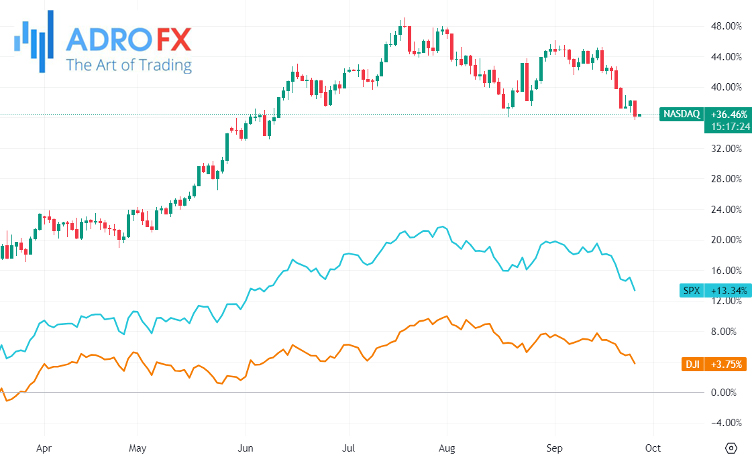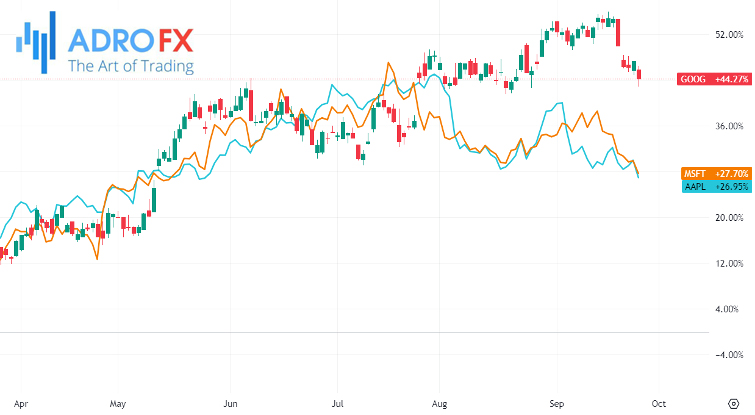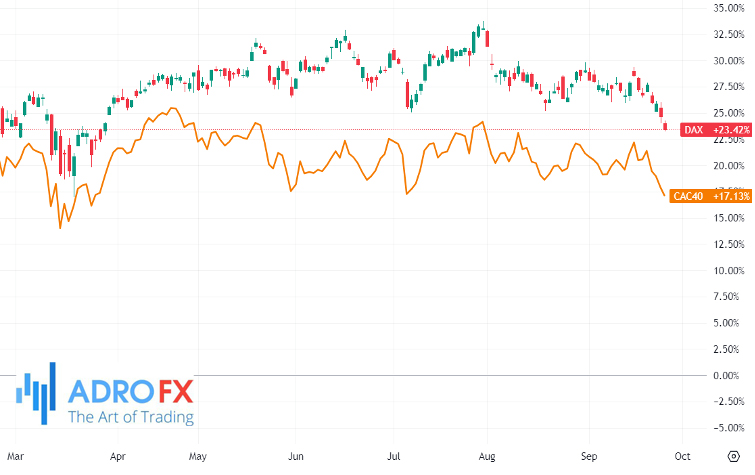US Stocks Extend September Slide Amid Fed Hawkishness and Shutdown Fears; European Markets Follow Suit | Daily Market Analysis

Key events:
- USA - Core Durable Goods Orders (MoM) (Aug)
- USA - Crude Oil Inventories
US stocks continued their decline on Tuesday, extending losses for the month. Concerns among investors persist about the possibility of interest rates remaining elevated for an extended period and the potential impact of a government shutdown.
The primary indices on Wall Street are still grappling with the aftermath of the recent Federal Reserve meeting, which surprised markets with its hawkish tone. Policymakers indicated their intention to raise rates again this year and reduce rate cuts for the next year, a significant departure from the four cuts forecasted in June. The Fed's message was clear: interest rates need to remain higher for an extended duration to counteract inflation pressures and steer it back toward the 2% target rate.
Minneapolis Federal Reserve Bank President Neel Kashkari emphasized this point on Monday, underscoring that, given the unexpectedly robust state of the US economy, the Fed likely needs to continue raising borrowing rates and maintain them at elevated levels to tame inflation effectively.
While there was a brief respite on Monday when the benchmark S&P 500, tech-heavy Nasdaq Composite, and the 30-stock Dow Jones Industrial Average saw gains, snapping their four-day losing streaks, the overall picture remains grim for September. The tech-heavy Nasdaq Composite, in particular, has endured a tough month, with a 5.4% decline, poised for its worst performance since December. Meanwhile, the S&P 500 and Dow Jones Industrial Average have posted losses of 3.8% and 2.1%, respectively, making it a challenging September for investors.

Adding to the prevailing concerns in the market is the looming uncertainty surrounding a potential federal government shutdown, a development that could have adverse consequences for the country's creditworthiness, as warned by Moody's Investors Service on Monday. While lawmakers on Capitol Hill are striving to reach an agreement, even a temporary funding measure to buy more time, the rapidly approaching Saturday deadline adds to the unease.
It's noteworthy that Moody's caution comes shortly after Fitch downgraded the US by one notch due to a debt ceiling crisis, making Moody's the last major rating agency to uphold the US's prized triple 'A' rating.
Meanwhile, economic indicators revealed mixed news. August new home sales fell below expectations, coming in at 675,000, while September's consumer confidence figure, registering at 103, also fell short of expectations.
For big tech, the respite seen on Monday was short-lived, as investors continue to factor in the challenges facing growth stocks in the face of an enduring period of higher interest rates. Alphabet led the decline with a 2% drop, followed by Microsoft and Apple. The outlook for growth stocks is impacted as higher rates diminish the perceived future profitability, a concern particularly pronounced in the higher-priced growth sectors, including technology.

Further compounding the challenges, Amazon faced a more than 4% drop following the Federal Trade Commission's filing of an antitrust lawsuit against the online retail giant. The lawsuit alleges anticompetitive and unfair practices aimed at maintaining an illegal monopoly. Amazon swiftly responded, with its general counsel, David Zapolsky, asserting that the allegations were unfounded and expressing readiness to defend the company's position in court.

European markets faced another day of declines, with the DAX and CAC 40 hitting their lowest points in the past six months. This downward trend can be attributed to firmer yields and concerns about stagflation, leaving markets on shaky ground. Additionally, technical factors may be at play as both the French and German benchmarks recently dipped below their respective 200-day Simple Moving Averages (SMA).

The strengthening of the US dollar, coupled with rising yields, reflects a belief that persistent inflation will endure, thereby keeping interest rates at elevated levels. This sentiment is bolstered by the fact that oil and gasoline prices show little inclination to retreat from their recent highs.
The surge in the US dollar is presenting challenges for the Bank of Japan, as Japanese Finance Minister Suzuki expressed a heightened sense of urgency regarding recent currency movements. Suzuki indicated a willingness to take appropriate action against rapid fluctuations in the exchange rate. However, the momentum appears to be favoring the US dollar, while the Bank of Japan continues to advocate for further easing measures.

The prospect of sustained inflation in the US implies that the Federal Reserve is likely to lean toward keeping interest rates higher for an extended period. As a result, the path of least resistance for USD/JPY seems to be toward surpassing the 150 level and potentially reaching last year's peak at 152.00, unless the Bank of Japan makes an abrupt policy shift.










